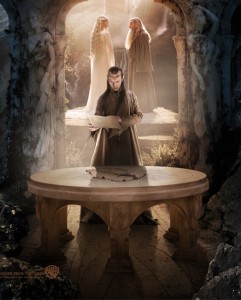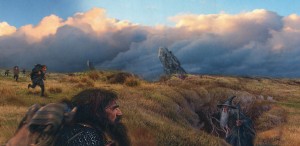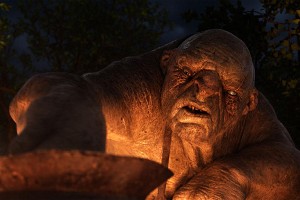The Morgul-blade revealed!
 Now that we’ve dispensed with the preliminaries, let’s get to the good stuff. In my humble opinion, the best of these questions is: who lost the Morgul-blade? Because a mere Morgul-blade doesn’t mean much. Consider, for example, the obvious and common guess that the blade is found in the troll’s treasure along with Orcrist, Glamdring, and a Sting to be named later. (Never mind that that’s bad storytelling, as it fails to make the finding of the blade special in any way.) Elrond tells us that the trolls must have “plundered other plunderers” in a succession that reaches all the way back to the fall of Gondolin in the First Age. And in fact there’s no reason why a Morgul-Blade from a thousand years ago, before the Witch-king was defeated, couldn’t be found in any treasure-hoard. Nope, you can’t just find a Morgul-blade. You have to know it was recently used by an enemy.
Now that we’ve dispensed with the preliminaries, let’s get to the good stuff. In my humble opinion, the best of these questions is: who lost the Morgul-blade? Because a mere Morgul-blade doesn’t mean much. Consider, for example, the obvious and common guess that the blade is found in the troll’s treasure along with Orcrist, Glamdring, and a Sting to be named later. (Never mind that that’s bad storytelling, as it fails to make the finding of the blade special in any way.) Elrond tells us that the trolls must have “plundered other plunderers” in a succession that reaches all the way back to the fall of Gondolin in the First Age. And in fact there’s no reason why a Morgul-Blade from a thousand years ago, before the Witch-king was defeated, couldn’t be found in any treasure-hoard. Nope, you can’t just find a Morgul-blade. You have to know it was recently used by an enemy.
And who could that be? Who might be wielding a Morgul-blade, other than a Nazgûl?
A barrow-wight, that’s who. A barrow-wight, as in a spirit re-animated by necromancy.
That’s right, Gandalf, Bilbo, and the Dwarves must unexpectedly encounter and defeat a wight—and this discovery of necromancy is itself possible evidence that Sauron the Necromancer has returned to Middle-Earth. The White Council meeting is probably as much about the encounter with the barrow-wight as it is about the retrieval of the Morgul-blade from him; we’ve been shown the latter to whet our appetites while the former has been kept under wraps. Yet the Morgul-blade is far from trivial. To create the proper level of uncertainty within the Council, necromancy of this simple sort must be rare but not unheard of in Jackson’s version of the history; presumably Sauron taught the art to other, lesser practitioners, and that knowledge has been passed down through the ages. That the corpses in the barrows of the ancient kingdom of Cardolan (I’m guessing this happens somewhere east of Bree) have become reanimated does not necessarily point to the Necromancer as the culprit. But if they have been armed with Morgul-blades, that makes it far more likely.

First, and most importantly, it inserts an adventure between Hobbiton and the Trollshaws. In FOTR that journey fills nearly twenty-five minutes of action (in thirty-four of running time, the other nine being three Saruman sequences). Without an added adventure, The Hobbit would likely cover the same territory in a fifty-second montage of walking and running to the tunes of Howard Shore, a la the Ring going south in FOTR. And that would seem odd and abrupt to everyone familiar with the FOTR version of this journey.
Second, if Gandalf stays behind to further investigate signs of barrow-wight activity, it provides a much more satisfying reason than the book’s for his absence when they encounter the trolls, and hence a much more dramatic reappearance (and of course explains why he is missing from all of the walking and running footage in the second trailer).

And fourth, it would break up the comic tone that dominates the story from the Unexpected Party through the Trolls. (I was thrilled to see Thomas Monteath make the same guess in his September 5 piece on the figurine character biographies, and I hope I’ve provided the rationale that he mostly left missing.)
Oh, and “Fog on the Barrow-Downs” rocks. (Or “standing stones,” if we can make that a verb.)


